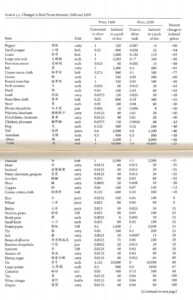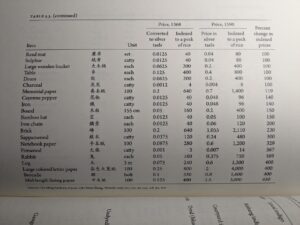Another book I got for the holidays is Tim Brook. The Price of Collapse: The Little Ice Age and the Fall of Ming China. Princeton, 2023.
Oddly enough, I read the whole thing from cover to cover, which is not always how I read academic books. The thing that makes this one such a joy is that it is both a collection of interesting stories and facts about the economic and ecological history of Ming China, and a discussion of price history and the role of the Little Ice Age in the fall of the Ming.
The price history stuff is rather fragmentary, which makes sense since there are really no series of prices like Qing grain prices for the Ming. Instead you (well, Brook), need to comb through various sources looking for data. There are some good numbers on what things were supposed to cost for official purchases in the early Ming, and then a lot of price lists at the end of the Ming, when the wheels are coming off, and everyone was complaining about how much things cost nowadays. In between there are the occasional lists of prices like those compiled by the honest official Hai Rui.
For 1/100 of an ounce of silver (one cent) you could get a catty of cucumbers, 18 eggs, a porcelain soup bowl, 2 exercise booklets a catty of hemp rope or 10 catties of coal.
1/10 of an ounce of silver would get you a wok or a wooden bed, a catty of winter melon or fine tea, a bolt of linen cloth or a visit from a doctor.
A full tael of sliver (1.3 oz to us) would get you a stove, an inkstone, 100 sheets of letter paper, a Spanish style gun, 4 volumes of Tang poetry, two new year door gods paintings, or a boy singer. I should add that one tael is pretty cheap for a person. 4 to 10 taels was the range for domestic servants, according to the diary of a Shanghai resident of the 1590s, although he got a bargain, getting a housepainter and his wife for only two taels in the famine year of 1588. (pg40-45)
So how much money was that?
For the early Ming, 3 cents of silver a day (20-25 copper coins) or 10.2 taels per year was about the minimum wage. This is about what military laborers got. Silk weavers could get 4 cents a day, 6 if they had their own loom, and by the end of the dynasty 4 cents a day was the standard minimum wage (pp58-60) This is actually a large increase in bottom end wages over the time period. Sailors heading out into the South China Sea could make 20-30 taels a year. For a lot of these groups, (and above all for farmers) the cash wage was probably not the only source of income. The military laborers above were absconding all the time, in part because the pay was bad and the work hard, but also because there was no way to make extra money. Potters at Jingdezhen got 3 cents and 5 coppers a day, which was barely over minimum. They also got a grain allotment, however, which may have been worth 5 ½ taels a year, and would put them into the bottom of the respectable class. They may have also sold off porcelain on the side, which happened a lot at Jingdezhen. A prison warden (rank 9b, the bottom of the official scale) got 19.52 taels in 1567, although also with a great opportunity to collect bribes and fees.
As you can sort of see from the prices above, the costs of ordinary living were just barely within reach of the poor. Even “capital goods” like a (small) wok were only 1/10 tael. Four volumes of poetry for 1 tael? Mass education here we come. One tael was about the dividing line for tempting someone to commit a crime Ming stories.
Brook ”If we recall the earlier estimates of the cost of living (just over 14 taels for a family living close to subsistence, and just over 23 taels for a respectable family) and compare these with these wage data (a poor wage between 5 and 12 taels, a respectable wage of between 14 and 22 taels” (pg 60)
There was a very different level of living for the rich, however. Officials in Beijing in the Wanli era were said to spend 4-5 taels a month, and a top quality painting could cost 30 – 300 taels, which is far more than an ordinary family would spend in a year.
The painting point is kind of important. Although Brook does not say so, you can sort of see evidence for a growing mass prosperity in the Ming (and into the Qing). True, the first bad dip of the Little Ice Age creates a crisis, but the long-term increase of bottom end wages of about 33% is significant, and recorded prices for necessities are within the range of a lot of people. The price of art, however, especially good art, skyrockets.
Brook does not see the world silver trade as being the main driver of Late Ming inflation and economic chaos, and if you want a good recent summary of stuff on the silver issue this is it. True there were a lot of people lamenting the rising prices of things, but in non-famine years prices of many ordinary goods fell between 1368 and 1590, with rice and wheat remaining exactly the same. (see table below) Some of the things that went up, like firewood and rabbits, might indicate less “waste” land, which fits with the received picture.
Art was going up, maybe, because silver -was- flowing in from the New World, and it was driving up prices, but that was more at the top end of the market, where things like authentic Song paintings were in limited supply. The Ming elite may not have been going in for some of the same ways of showing off new fashions and such that European elites were. So maybe there was growing prosperity at the bottom and middle, with wild inflation at the top. Right where down on their luck scholars would write about it.
Regardless of what was happening in the late Ming, the Qing was convinced that the rural economy was on the brink of collapse form over taxation (See this post) https://froginawell.net/frog/2023/12/qing-taxation/ and thus agricultural taxes remained stable throughout the dynasty, and maybe the black-headed people did better than we used to think in the Qing.
Sorry this post is sort of a mess, but I am teaching about this tomorrow, and wanted to save the data points somewhere I could find them.



Fascinating; I could definitely see this being a good read for my China to 1700 class, at least for the grad section.
I really enjoy Brook’s writing (and his impressive breadth of expertise) and has been interesting to see him evolve over the course of his various books. I’ll have to add this one to my list!